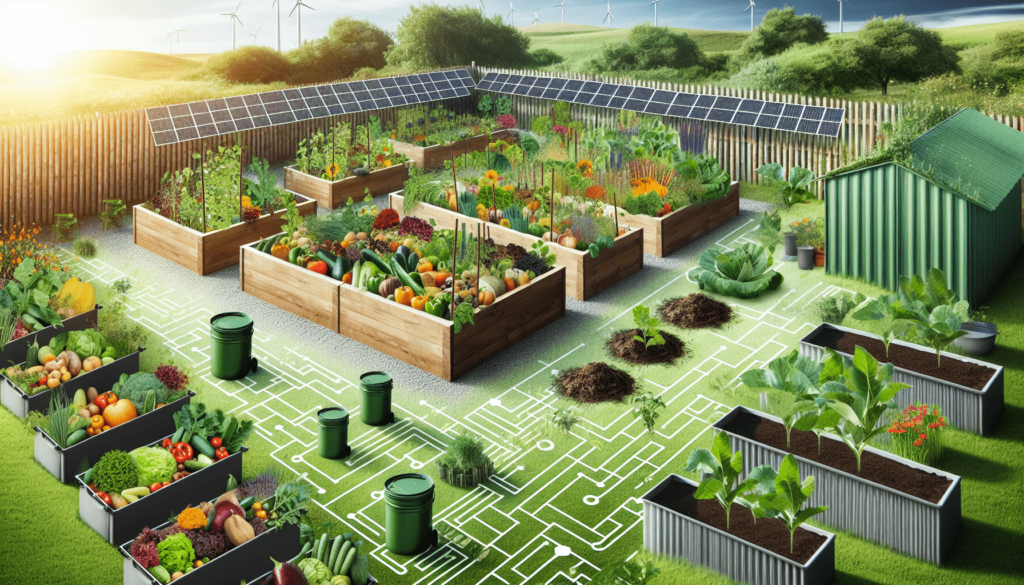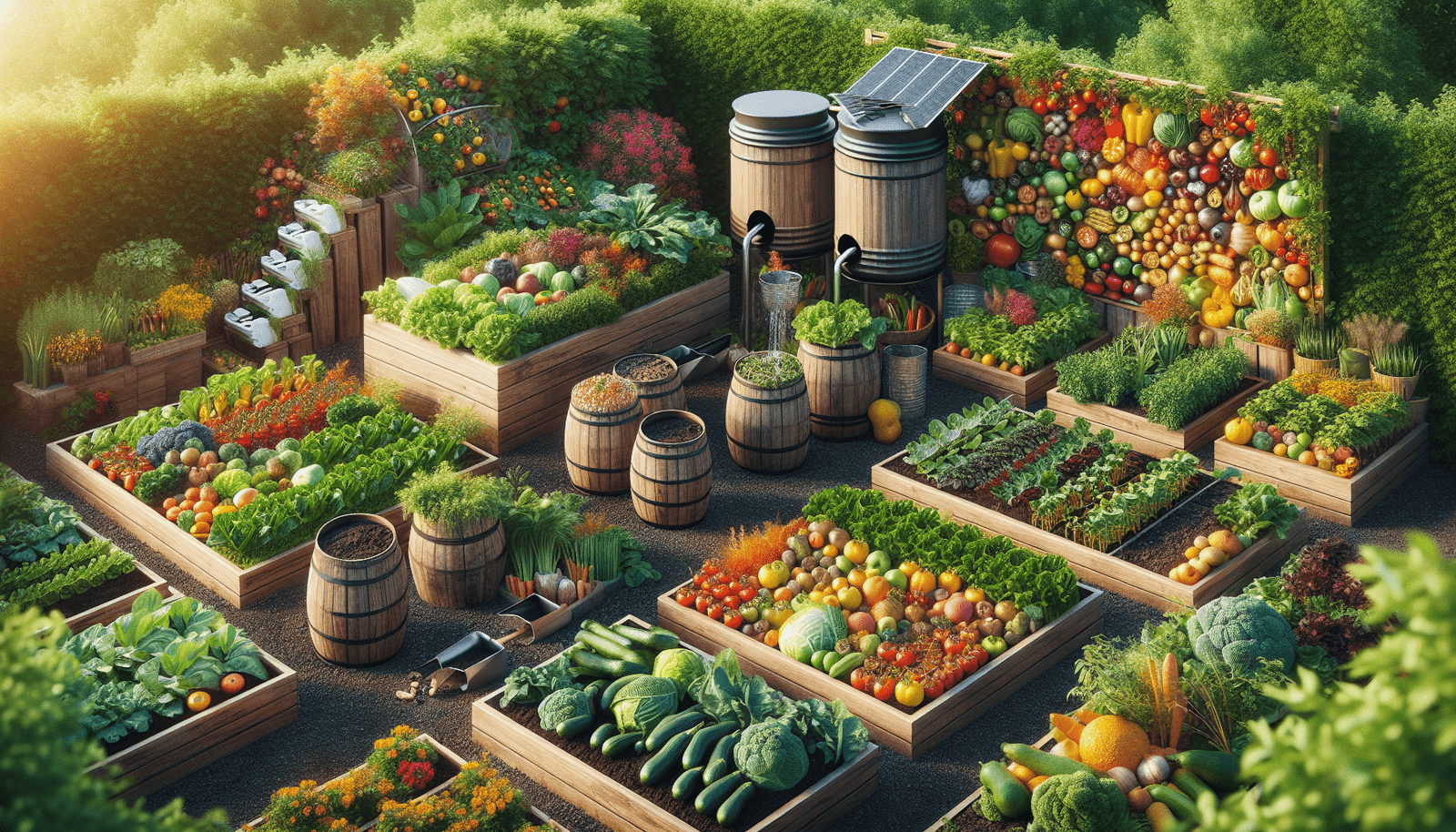Are you looking to create a garden that not only enhances the beauty of your home but also promotes sustainable living practices? If so, you have come to the right place. In this ultimate guide, we will provide you with all the necessary information and tips to help you create a garden that is not only aesthetically pleasing but also environmentally friendly. So, roll up your sleeves and get ready to transform your outdoor space into a sustainable haven.
Why Should You Create a Sustainable Garden?
Creating a sustainable garden has numerous benefits, both for you and the environment. Not only does it allow you to enjoy the beauty of nature right in your backyard, but it also helps reduce your carbon footprint and promote biodiversity. By implementing sustainable practices in your garden, you can conserve water, reduce chemical usage, and provide habitats for local wildlife. Overall, creating a sustainable garden is a win-win situation for both you and the planet.
Benefits of a Sustainable Garden
Creating a sustainable garden offers a wide range of benefits, including:
- Reduced water usage
- Decreased reliance on harmful chemicals
- Support for local wildlife
- Improved soil health
- Increased aesthetic appeal
Planning Your Sustainable Garden
Before you start digging in the dirt, it’s essential to have a solid plan in place for your sustainable garden. Planning is crucial to ensure that you make the most of your outdoor space while minimizing waste and environmental impact. Take the time to assess your garden’s current state, set clear goals for what you want to achieve, and create a detailed plan that outlines the steps you need to take to reach your objectives.
Assessing Your Garden
Begin by assessing your garden’s current condition, including factors such as soil quality, sunlight exposure, and existing plants. Determine what areas of your garden need improvement and identify any potential challenges you may face when implementing sustainable practices.
Setting Goals
Once you have a clear understanding of your garden’s current state, it’s time to set goals for your sustainable garden. Do you want to create a pollinator-friendly space, grow your own food, or simply reduce your environmental impact? Whatever your objectives may be, make sure they are specific, measurable, achievable, relevant, and time-bound (SMART) to keep you focused and motivated.
Creating a Garden Plan
With your goals in mind, create a detailed garden plan that outlines the layout, plant selection, and maintenance schedule for your sustainable garden. Consider factors such as companion planting, water conservation, and soil health when designing your garden plan to ensure that it aligns with your sustainability goals.

Designing Your Sustainable Garden
The design of your garden plays a crucial role in its sustainability. By carefully planning the layout, plant selection, and features of your garden, you can create a space that is not only beautiful but also eco-friendly. When designing your sustainable garden, consider factors such as water efficiency, biodiversity, and resource conservation to maximize its environmental benefits.
Layout and Design
When designing your sustainable garden, pay close attention to the layout and design of your outdoor space. Consider factors such as sun exposure, wind patterns, and existing structures when determining the placement of plant beds, pathways, and seating areas to maximize efficiency and aesthetics.
Plant Selection
Choosing the right plants for your sustainable garden is essential to its success. Opt for native and drought-tolerant species that require minimal water and maintenance, and attract beneficial pollinators and wildlife to your garden. Consider factors such as bloom times, growth habits, and soil requirements when selecting plants to ensure they thrive in your garden’s environment.
Features and Elements
Incorporating sustainable features and elements into your garden design can further enhance its environmental benefits. Consider adding rainwater harvesting systems, compost bins, and wildlife habitats to promote resource conservation, recycling, and biodiversity in your garden. By incorporating these elements, you can create a holistic and sustainable outdoor space that benefits both you and the environment.
Implementing Sustainable Practices
Once you have a solid plan and design in place, it’s time to put your sustainable garden into action. Implementing sustainable practices in your garden is essential to its long-term success and environmental impact. By following eco-friendly gardening techniques, you can conserve resources, reduce waste, and support local ecosystems while enjoying the beauty of nature right in your backyard.
Water Conservation
Conserving water is one of the most critical aspects of sustainable gardening. Implement water-saving techniques such as mulching, drip irrigation, and rainwater harvesting to minimize water usage and promote healthy plant growth in your garden. By reducing water waste, you can decrease your water bill and help protect local water sources for future generations.
Soil Health
Maintaining healthy soil is essential for a sustainable garden. Practice soil-building techniques such as composting, crop rotation, and cover cropping to improve soil fertility, structure, and nutrient content. Healthy soil not only supports plant growth but also sequesters carbon, reduces erosion, and enhances biodiversity in your garden.
Pest and Weed Management
Effective pest and weed management is crucial for maintaining a healthy and thriving garden. Avoid using synthetic pesticides and herbicides that can harm beneficial insects, wildlife, and the environment. Instead, opt for natural and organic pest control methods such as companion planting, hand-picking pests, and using insecticidal soaps to manage pests and weeds in your garden safely and sustainably.

Maintaining Your Sustainable Garden
Keeping your sustainable garden healthy and thriving requires regular maintenance and care. By following proper maintenance practices, you can ensure that your garden continues to support biodiversity, conserve resources, and promote sustainable living for years to come. From watering and weeding to pruning and harvesting, every task you perform in your garden plays a vital role in its sustainability.
Watering
Proper watering is essential for maintaining a healthy and vibrant garden. Water your plants deeply and infrequently to encourage deep root growth and reduce water waste. Consider using a rain gauge or soil moisture meter to determine when your plants need watering and adjust your watering schedule accordingly to conserve water and promote plant health in your garden.
Weeding
Regular weeding is necessary to keep your garden free of invasive plants and weeds that can compete with desirable plants for resources. Mulching, hand-pulling weeds, and using organic weed control methods can help minimize weed growth and maintain a tidy and healthy garden environment. By staying on top of weeds, you can reduce the need for herbicides and promote a thriving ecosystem in your garden.
Pruning
Pruning is an essential maintenance task that helps promote plant health, growth, and aesthetics in your garden. Remove dead, diseased, or damaged branches regularly to encourage new growth and improve air circulation and sunlight exposure for your plants. Proper pruning not only maintains the health and structure of your plants but also prevents pest and disease problems in your garden.
Enhancing Biodiversity in Your Garden
Promoting biodiversity in your garden is essential for creating a healthy and resilient ecosystem that supports a wide range of plants, insects, and wildlife. By implementing biodiversity-friendly practices in your garden, you can attract beneficial pollinators, natural enemies of pests, and other wildlife that contribute to a balanced and sustainable environment. From planting native species to providing habitat structures, there are numerous ways you can enhance biodiversity in your garden.
Planting Native Species
Planting native species is one of the most effective ways to enhance biodiversity in your garden. Native plants are adapted to your local climate, soil, and wildlife, making them well-suited to provide food, shelter, and nesting sites for local insects and wildlife. By incorporating a variety of native plants in your garden, you can attract beneficial pollinators, birds, and other wildlife that contribute to a healthy and diverse ecosystem.
Providing Habitats
Creating habitats for wildlife in your garden is essential for supporting biodiversity and promoting a balanced ecosystem. Install birdhouses, bee hotels, butterfly feeders, and bat boxes to provide nesting sites and food sources for beneficial insects and wildlife. Additionally, consider leaving areas of your garden wild and untouched to provide shelter and habitat for native species that contribute to a thriving and diverse ecosystem.
Avoiding Chemicals
Avoiding the use of synthetic chemicals in your garden is crucial for promoting biodiversity and protecting the environment. Chemical pesticides, herbicides, and fertilizers can harm beneficial insects, wildlife, and soil organisms, disrupting the natural balance of your garden ecosystem. Instead, opt for natural and organic gardening practices that support biodiversity, such as companion planting, crop rotation, and biological pest control methods, to create a healthy and sustainable environment for all living organisms in your garden.
Conclusion
Creating a sustainable garden is not only a rewarding experience but also a meaningful way to promote environmental stewardship and conservation in your everyday life. By following the tips and techniques outlined in this ultimate guide, you can transform your outdoor space into a beautiful, eco-friendly oasis that supports biodiversity, conserves resources, and promotes sustainable living practices. Remember, every small step you take towards creating a sustainable garden makes a significant impact on the planet and future generations. So, grab your gardening gloves, get outside, and start creating a garden that not only enhances your home but also sustains the planet for years to come.

